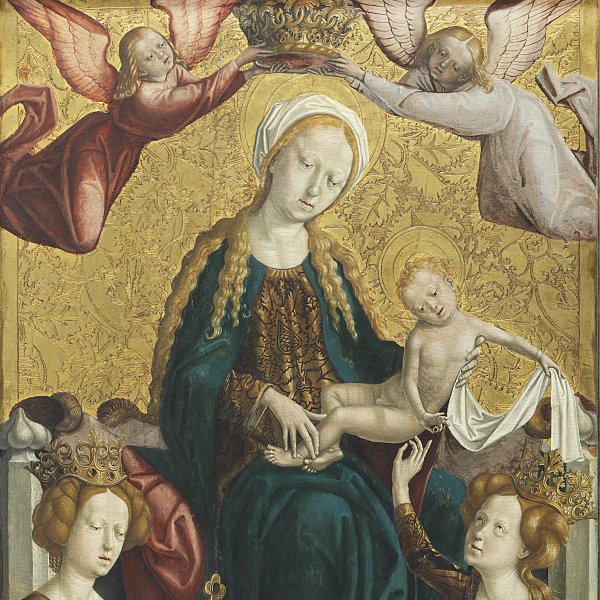Saint Jerome as a Cardinal
The Master of Grossgmain was an Austrian painter active around 1500 whose name derives from the panels of an altarpiece in the church of the Ascension in Grossgmain, a city near Salzburg. It is thought that he may have trained with Rueland Frueauf the Elder, whose influence is evident in his work. The present artist’s style is characterised by the use of architectural structures that slightly compress the pictorial space into which the figures are inserted. Here he depicts Saint Jerome dressed as a cardinal and seated at a desk with an open book, referring to his labours as a Doctor of the Church. Leaning against the saint’s legs is the lion whose wounded paw Jerome cured, according to the Golden Legend. A notable element is the saint’s cloak, which gives the figure a sense of monumental volume and which falls down to occupy all the lower part of the composition. The figure of Jerome has been compared to paintings of Saint Ambrose and Saint Augustine in the Österreichische Galerie in Vienna, and to one of an Abbot Saint in a collection in Regensburg.
NR
Saint Jerome as a Cardinal was in the Figdor collection in Vienna and was auctioned Berlin in 1930. It entered the Rohoncz collection two years later in 1932. The panel, which was first published at the start of the 20th century, was attributed to Rueland Frueauf and was recorded as such in the catalogues of the Thyssen-Bornemisza collection until the late 1960s. Its current attribution was first proposed in 1929 by Otto Pächt who was the first to associate it with the Master of Grossgmain, an attribution adopted by Christian Salm in the 1969 catalogue of the Thyssen-Bornemisza collection. This suggestion has been upheld by other authors who have studied the painting.
Saint Jerome is depicted as a cardinal and Doctor of the Church. He can be identified by his cardinal’s hat, the red colour of his garments and the open book on the desk that refers to his labours. In addition the lion refers to the legend of the saint (as well as being the symbol of the Evangelist Mark). The story of Saint Jerome and the lion was promoted through The Golden Legend. It narrates how one afternoon, Jerome and various monks were outside the monastery reading and listening to holy texts when a lion arrived with a wounded paw. Saint Jerome approached the animal, which stretched out its paw and the Saint instructed the monks to wash and examine it, resulting in a thorn being extracted. After it was cured the lion remained in the monastery as a pet and Jerome placed it in charge of the monks’ donkey.
The artist presents Saint Jerome as he pauses in his labours, which are referred to in the open book on the desk. He strokes the tame lion, which rests its front paws on the saint’s knees. Jerome’s figure is constructed in a volumetric manner and the ample cardinal’s robe that he wears, with its carefully constructed folds and contours, occupies almost the entire lower half of the composition. The desk and book create a pronounced diagonal that is counterbalanced by the saint’s position on the stone bench and the plain blocks of masonry that construct the setting.
The painting has been related to two others of bishop saints that have tentatively been identified as other Doctors of the Church, namely Saint Ambrose and Saint Augustine (Österreichische Galerie, Vienna). The setting in these two panels is similar to the present one, although more complex. Another work associated with this group is the Abbot Saint in Ratisbon, which has been suggested to be Saint Benedict. The two Doctors of the Church in Vienna are dated to the same year as the present panel, and this date has also been accepted for the Ratisbon panel.
Mar Borobia









